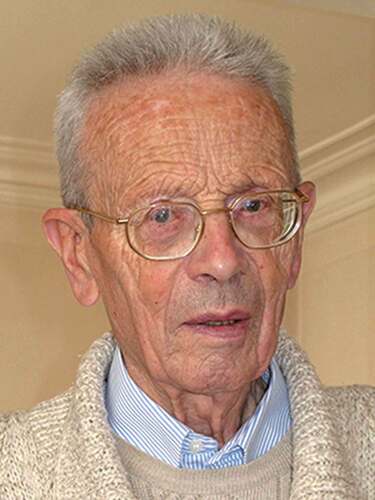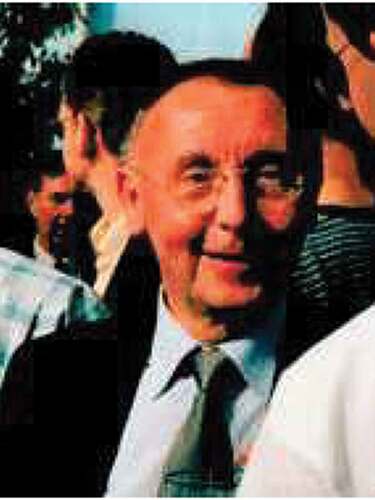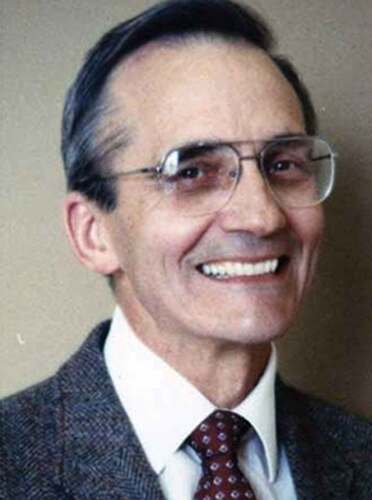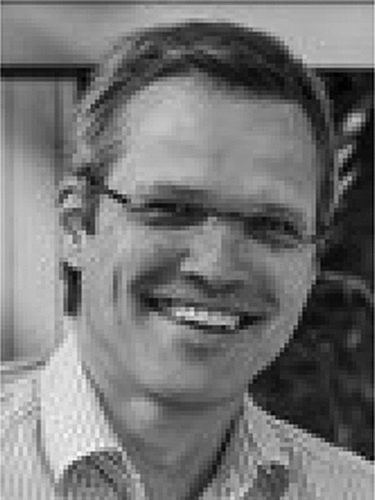Philippe Mérat
29 February 1927–18 March 2020
We have learned the sad news that Philippe Mérat passed away on 18 March 2020, in his 92nd year, and offer our condolences to his family.
Philippe Mérat was a pioneer in poultry genetics at INRA and around the world. He was the director of the Factorial Genetics laboratory at the Jouy-en-Josas Research Centre, from 1976 to 1991. He has been a member of the International Poultry Hall of Fame of the World Poultry Science Association since 1988, at the beginning of this distinction. Philippe was one of the founders of the Vedette breeder hen, the first innovation in animal genetics patented by INRA in 1976. His insatiable scientific curiosity first led him to study the genetic determinism of so-called ‘visible’ phenotypes, such as dwarfism, the ‘naked neck’ gene, curly plumage, blue shell, etc. He relied mainly on experimentation to analyse the effects associated with these phenotypes on performances of economic interest, such as the number of eggs or feed efficiency of laying hens. With André Bordas, he initiated selection on residual feed consumption, which is still a highly studied trait on several farmed species. As the limits of the ‘visible’ evolved, he became interested in blood protein or egg white polymorphisms and supported the entry of factorial genetics into the molecular era, with the first ‘RFLPs’. Long before climate change research, he was interested in heat adaptation, and had a passion for developing alternatives to industrial breeding for developing countries. In particular, he launched a collaboration with Egypt that led to the completion of three PhD theses and the importation, in 1978, of a population of the Fayoumi breed, a small hen remarkable in many ways, notably for its resistance to diseases. It is still today a precious biological resource maintained at the INRAE Pôle d’Expérimentation Avicole de Nouzilly. In 1989, he organised a European symposium in Jouy-en-Josas on genotype x environment interactions, which led to the publication of a book which is still useful and relevant today. He had already begun to study the effect of heat stress of the dam on the growth of its chicks before the term ‘epigenetics’ was coined. At that time, tools to explore the genome were lacking, but Philippe had already identified the issues for the future.
On a personal level, Philippe was a kind man and always gave unfailing support to young researchers who joined his laboratory. He was very shy, and wrote much more easily than he expressed himself in public, with more than 150 articles and papers to his credit. However, the visit of the TV Collaro Show journalists who came to interview him on the blue egg has remained in the memories of those in the lab. Another highlight was the visit of Sir Carefoot, an English entrepreneur with a passion for the diversity of chicken breeds, who memorably took Philippe in his Jaguar car to visit the La Minière experimental farm.
A great and discreet gentleman has left us.
George De Groote
20 March, 2020
The Belgian branch of WPSA is sad to announce the passing away on 20 March 2020 of its former president Ir. George De Groote (84). He will be remembered as a Belgian authority in the domain of Poultry Nutrition and Husbandry in various leading positions, including Director of the Research Station for Small Animal Husbandry (RvK: 1973-1998 – Merelbeke), Head of Department of Animal Husbandry & Nutrition (actual ILVO-Dier – Melle), President of the Belgian Branch of WPSA (1978–2003). Active and inspiring member of the Working Group 2 – Nutrition, of the European Association of WPSA; headed the ESPN-2001 in Blankenberge, Former president of the Section Animal Nutrition & Husbandry of the Royal Flemish Association of Engineers, K.VIV, Board Member and Editorial board member of poultry-related organisations and magazines.
As scientist, De Groote will be remembered as one of the pioneers and defenders of the NE-system in Poultry, the introduction of the ‘Digestible Amino Acid’ concept and Linear Programming for optimisation in feed formulation. This was a logical consequence of his mathematical and modular approach and evaluation.
G. De Groote was a very friendly and empathic personality, father of two children. He was a fervent tennis player during his leisure time (International congresses included).
WPSA-Belgium
Luc Goethals, President
Joseph M. Vandepopuliere
21 June 1929–26 January 2020
Dr Joseph M. Vandepopuliere passed away Sunday, 26 January 2020 at home surrounded by family. He was 90.
He received his BSc in Biology from Central Missouri State, a MSc in Chemistry from the University of Missouri-Columbia and a PhD in Animal Nutrition from the University of Florida-Gainesville.
Joe began his career at Ralston Purina after receiving his MSc. At Purina, he was heavily involved in developing companion animal diets which led to the highly successful line of ‘Chows’ for dogs, cats, monkeys, and fish.
Upon the completion of his PhD, Joe was rehired by Purina where he spent 12 more years conducting broiler research and technical support of poultry sales personnel and producers throughout North America.
In 2006, Joe was named a PSA Fellow. This honour highlighted Joe’s success with Purina as well as his research that focused on utilisation of poultry by-products, spent hens, skeletal problems and ectoparasite control. At the time of his award as Fellow, Joe held three US patents and had contributed to over 180 scientific articles and trade publication reports. In addition, Joe also served 3 years as PSA Secretary and served WPSA-USA as Director (1984–1988) and President (1988–1992).
Ass. Prof. Dr Knut Niebuhr
1963–2020
On 1st February 2020 Dr Knut Niebuhr’s eyes shut forever after a patiently endured serious illness.
Dr Knut Niebuhr studied veterinary medicine at the University of Pisa and the LMU Munich. For his doctoral thesis on the resettlement of the bearded vulture, he came to the University of Veterinary Medicine Vienna, where he received his doctorate in 1996 and also worked for the Bearded Vulture project as a research assistant. From December 1997 he worked as a university assistant at the Institute for Animal Husbandry and Animal Welfare (since 2019 Institute of Animal Welfare Sciences), since 2008 as an assistant professor and head of the poultry working group.
For many years he was also Secretary of the Austrian WPSA branch.
The focus of his work was on the behaviour, husbandry and well-being of laying hens in various husbandry systems and production forms, but he also devoted himself to fattening poultry. So Dr Knut Niebuhr various projects, e.g. to use the run of laying hens, to use bridges or tunnels as access to runs, to design the run for broilers and to evaluate new husbandry systems for laying hens. In particular, his research on factors influencing feather pecking and cannibalism in laying hens led to a concept in husbandry and management that can now be used to shorten the beaks. These results also attracted great international attention and contributed significantly to improving animal welfare for laying hens. During his work, he always tried to find practical solutions and was therefore in close contact with the various actors in poultry practice. His research also took place in practice on poultry farms; he himself worked on hundreds of companies for data collection and advice. In addition to research, he was also very enthusiastic about teaching at the university and transferring knowledge into practice. With enthusiasm, he was not only able to arouse students’ understanding of animals and their behaviour and provide them with the basis for scientifically based animal welfare, but also to help practitioners find ways of animal-friendly poultry farming and avoiding problems.
Beyond Austria’s borders, Dr Niebuhr will be remembered as a razor-sharp thinker, recognised expert, courteous colleague, good friend and great person.




